

Gypsum board stacked on edge or end is unstable and presents a serious hazard should it accidentally topple. Gypsum board shall always be stacked flat - NEVER on edge or end. Individuals delivering gypsum board to jobsites should ensure that it is carried, not dragged, to place of storage/installation to prevent damage to finished edges. Gypsum board must be delivered to the job site as near to the time it will be used as possible. Sufficient risers must be used to assure support for the entire length of the wallboard to prevent sagging. Gypsum board must be stored off the ground and under protective cover. For additional information, refer to Gypsum Association publication," Guidelines for the Prevention of Mold Growth on Gypsum Wallboard" (GA-238). Gypsum board that has visible mold growth must not be used. Failure to remove the shipping bag can increase the likelihood of developing conditions favorable to the growth of mold. Plastic shipping bags are intended to provide protection during transit only and must be promptly removed upon arrival of the load. Gypsum board must be protected during transit with a weather-tight cover in good condition. Job site conditions that can expose gypsum board to water or moisture must be avoided. Gypsum board must be stored in an area that protects it from adverse weather conditions, condensation, and other forms of moisture.

GYPSUM BOARD MUST BE KEPT DRY to prevent the growth of mold. However, mold spores are present everywhere and when conditions are favorable mold can grow on practically any surface. "As far as writing skills of students are concerned, we are considering exempting language papers from this pattern, so we could test writing skills of students," Pathan said.Gypsum board does not generate or support the growth of mold when it is properly transported, stored, handled, installed, and maintained.

The questions will also save students from rote learning and make them more concerned about understanding concepts behind a theory, those in favour of the proposed system have said. The proposal is being considered as several members of the Board are of the opinion that this will prepare students for future competitive examinations like engineering and medical entrances more efficiently. It also reduced time to solve such questions from 75 minutes to 60 minutes from this year in order to avoid possible cheating. The Board had introduced 50% objective-type questions in all subjects from 2010. "There are several aspects that need to be discussed when opting for 100% objective-type question based papers for Class X board exam, for which a committee headed by the vice-chairman of the Board has been formed," said M M Pathan, officer on special duty, GSHSEB.Īs per the proposal, all subjects barring language papers will have only multiple-choice questions, and questions will have to be solved on optical mark recognition (OMR) sheets in order to facilitate evaluation. If the committee considers the new pattern feasible, it would be introduced from the March 2015 board examination, a top-level Board official said. The Board has also formed a 15-member committee to decide on the feasibility of the proposal to introduce papers based only on multiple-choice questions. To save students from rote learning and ensure faster, error-free evaluation, the Gujarat Secondary and Higher Secondary Education Board (GSHSEB) is considering to introducing 100% objective-type questions for most subjects in Class X board examination from 2015.


 0 kommentar(er)
0 kommentar(er)
